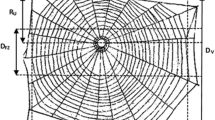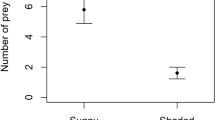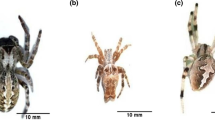Abstract
Spiders are the pre-eminent silk producers and many species construct orb webs to capture the insect prey. The present study was focused on the design and the orientation patterns of Neoscona theisi orb webs, during the crop growing seasons of rice and wheat. Architectural design of webs constructed by the orb web spider was examined in the crop fields by walking through the fields to locate the spider webs. Results revealed that web height and diameter increased along with increase in the diversity and availability of insect pests of rice. The proportion of vertically oriented webs of N. theisi increased progressively with increase in the availability of highly active and large-sized, prey in the paddy fields. In the wheat agroecosystem, the proportion of spiders without webs increased in response to the availability of the most abundant, small sized (with very low mobility) aphid prey, Sitobion avenae. It is likely that the adaptive plasticity in web size and orientation patterns exhibited by N. theisi not only helps it to maximize its prey capture efficiency but also plays an important role in contributing towards its dominance among the orb web-making species.






Similar content being viewed by others
Data availability
The datasets generated and analysed during the current study are available from the corresponding author on request.
References
Alam I, Butt A (2016) A study of web structure of Neoscona theisi (Araneae: Araneidae) under field conditions. Orient Insects 50:151–159
Awmack CS, Leather SR (2002) Host plant quality and fecundity in herbivorous insects. Annu Rev Entomol 47:817–844
Balaganesh G, Makarabbi G, Sendhil R (2019) Tracking the performance of wheat production in Uttar Pradesh. Ind J Econ Dev 15:216–224
Blackledge TA, Eliason CM (2007) Functionally independent components of prey capture are architecturally constrained in spider orb webs. Biol Let 3:456–458
Blackledge TA, Zevenbergen JM (2006) Mesh width influences prey retention in spider orb webs. Ethology 112:1194–1201
Blackledge TA, Kuntner M, Agnarsson I (2011) The form and function of spider orb webs: evolution from silk to ecosystems. Adv Insect Physiol 41:175–262
Blamires SJ (2010) Plasticity in extended phenotypes: orb web architectural responses to variations in prey parameters. J Exp Biol 213:3207–3212
Blamires SJ, Chao YC, Liao CP, Tso IM (2011) Multiple prey cues induce foraging flexibility in a trap-building predator. Anim Behav 81:955–961
Blamires SJ, Hasemore M, Martens PJ, Kasumovic MM (2017) Diet-induced co-variation between architectural and physicochemical plasticity in an extended phenotype. J Exp Biol 220:876–884
Blamires SJ, Martens PJ, Kasumovic MM (2018) Fitness consequences of plasticity in an extended phenotype. J Exp Biol 15:1–10
Catlin D, Gibson D, Friedrich MJ, Hunt KL, Karpanty SM, Fraser JD (2019) Habitat selection and potential fitness consequences of two early successional species with differing life-history strategies. Ecol Evol 9:13966–13978
Chander S, Aggarwal PK, Kalra N, Swaruparani DN (2003) Changes in pest profiles in rice-wheat cropping system in Indo-gangetic plains. Ann Plant Prot Sci 11:258–263
Foelix R (2011) Biology of spiders. OUP USA
Gan W, Liu S, Yang X, Li D, Lei C (2015) Prey interception drives web invasion and spider size determines successful web takeover in nocturnal orb-web spiders. Biol Open 4:1326–1329
Gregorič M, Agnarsson I, Blackledge TA, Kuntner M (2011) Darwin’s bark spider: giant prey in giant orb webs (Caerostris darwini, Araneae: Araneidae). J Arachnol 39:287–295
Heiling AM, Herberstein ME (2000) Interpretations of orb-web variability: a review of past and current ideas. Ecology 19:97–106
Herberstein ME, Tso IM (2000) Evaluation of formulae to estimate the capture area and mesh height of orb webs (Araneoidea, Araneae). J Arachnol 28:180–184
Herberstein ME, Craig CL, Coddington JA, Elgar MA (2000) The functional significance of silk decorations of orb-web spiders: a critical review of the empirical evidence. Biol Rev 75:649–669
Hormiga G, Griswold CE (2014) Systematics, phylogeny, and evolution of orb-weaving spiders. Annu Rev Entomol 59:487–512
Kallal RJ, Dimitrov D, Arnedo MA, Giribet G, Hormiga G (2020) Monophyly, taxon sampling, and the nature of ranks in the classification of orb-weaving spiders (Araneae: Araneoidea). Syst Biol 69:401–411
Kallal RJ, Kulkarni SS, Dimitrov D, Benavides LR, Arnedo MA, Giribet G, Hormiga G (2021) Converging on the orb: denser taxon sampling elucidates spider phylogeny and new analytical methods support repeated evolution of the orb web. Cladistics 37:298–316
Mayntz D, Toft S, Vollrath F (2009) Nutrient balance affects foraging behavior of a trap-building predator. Biol Let 5:735–738
Mishra A, Rastogi N (2020) Unraveling the roles of solitary and social web-making spiders in perennial ecosystems: influence on pests and beneficials. Proc Nat Acad Sci India Sect B Biol Sci 90:567–576
Mishra A, Kumar B, Rastogi N (2021) Predation potential of hunting and web-building spiders on rice pests of Indian subcontinent. Int J Trop Insect Sci 41:1027–1036
Nakata K (2008) Spiders use airborne cues to respond to flying insect predators by building orb-web with fewer silk thread and larger silk decorations. Ethology 114:686–692
Nakata K, Zschokke S (2010) Upside-down spiders build upside-down orb webs: web asymmetry, spider orientation and running speed in Cyclosa. Proc Royal Soc B Biol Sci 277:3019–3025
Nyffeler M, Sunderland KD (2003) Composition, abundance and pest control potential of spider communities in agroecosystems: a comparison of European and US studies. Agr Ecosyst Environ 95:579–612
Opell BD, Bond JE, Warner DA (2006) The effects of capture spiral composition and orb-web orientation on prey interception. Zoology 109:339–345
Scharf I, Lubin Y, Ovadia O (2011) Foraging decisions and behavioural flexibility in trap-building predators: a review. Biol Rev 86:626–639
Sharma AK, Singh T, Patel A, Yadav RA (2018) Influence of integrated nutrient management practices on scented rice (Oryza sativa L.) pertaining to eastern Uttar Pradesh. J Pharmacogn Phytochem 7:1448–1453
Soler A, Zaera R (2016) The secondary frame in spider orb webs: the detail that makes the difference. Sci Rep 6:1–10
Tahir HM, Butt A (2008) Activities of spiders in rice fields of central Punjab, Pakistan. Acta Zool Sin 54:701–711
World Spider Catalog (2022) World Spider Catalog. Version 23.5. Natural History Museum Bern, online at http://wsc.nmbe.ch. https://doi.org/10.24436/2. Accessed 20 Nov 22
Acknowledgements
The authors wish to thank the Director, Institute of Agricultural Sciences, for kindly permitting the field studies in the Agricultural farm of Banaras Hindu University.
Funding
This work was supported by University Grants Commission New Delhi, India (Grant number R/Dev/S(UGC-Research Fellow)/2014–15/87858).
Author information
Authors and Affiliations
Corresponding author
Ethics declarations
Ethical approval
This article does not contain any studies with human participants or animals performed by any of the authors.
Conflict of interest
The authors declare that they have no conflict of interest.
Additional information
Publisher's Note
Springer Nature remains neutral with regard to jurisdictional claims in published maps and institutional affiliations.
Rights and permissions
Springer Nature or its licensor (e.g. a society or other partner) holds exclusive rights to this article under a publishing agreement with the author(s) or other rightsholder(s); author self-archiving of the accepted manuscript version of this article is solely governed by the terms of such publishing agreement and applicable law.
About this article
Cite this article
Mishra, A., Rastogi, N. Does prey characteristics influence web-building plasticity of the ecologically dominant orb-web weaving spider, Neoscona theisi (Walckenaer 1841)?. Int J Trop Insect Sci 43, 257–265 (2023). https://doi.org/10.1007/s42690-022-00937-w
Received:
Accepted:
Published:
Issue Date:
DOI: https://doi.org/10.1007/s42690-022-00937-w




